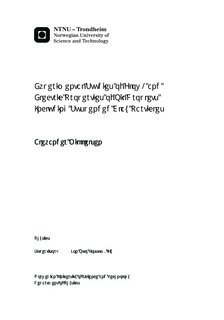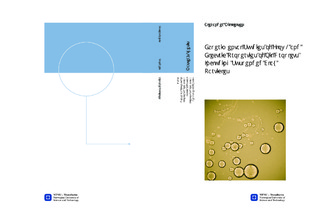| dc.contributor.advisor | Fossum, Jon Otto | nb_NO |
| dc.contributor.author | Mikkelsen, Alexander | nb_NO |
| dc.date.accessioned | 2014-12-19T13:17:30Z | |
| dc.date.available | 2014-12-19T13:17:30Z | |
| dc.date.created | 2012-06-21 | nb_NO |
| dc.date.issued | 2012 | nb_NO |
| dc.identifier | 536467 | nb_NO |
| dc.identifier | ntnudaim:6418 | nb_NO |
| dc.identifier.uri | http://hdl.handle.net/11250/246666 | |
| dc.description.abstract | Experiments on oil droplets made of silicone oil and sodium-fluorohectorite (Na-Fh) clay particles suspended in castor oil were performed. The electric field (E-field)-induced structuring of clay particles placed inside the droplet was studied using two optical microscopes with optical paths normal to one another. This configuration allowed for simultaneous observation of the droplet behavior from both a front view (optical path perpendicular to E-field lines) and a side view (optical path parallel to E-field lines). Prior to the application of the electric field, the Na-Fh particles were randomly dispersed inside and on the surface of the silicone oil droplet. The isotropic distribution in zero field was confirmed by adjusting the focus on the microscope and examining the intersection between the clay particles and focus plane. The application of direct current (DC) electric fields initiated clay particle movement inside the drop and the formation of a ribbon pattern consisting of short particle chains oriented parallel to the E-field direction. The ribbon formation rate displayed a linear E-field dependence and viscous flow inside the droplet seemed to govern the particle structuring. The viscous flow inside the drop was briefly studied together with the phenomenon of droplet rotation appearing at strong DC E-fields. The clay particles behaved differently when an alternating current (AC) E-field was applied. AC E-fields (with frequency equal to 200 Hz) produced chain patterns throughout the drop and parallel to the E-field direction. In both the AC and DC E-field, the particle alignment was time-dependent, and after the application of the E-fields, clay particles slowly spread out and clustered in the bottom of the drop. Settling experiments were also performed and revealed that the stress exerted by the surrounding castor oil on the settling silicone oil droplet was reduced by a factor approximately equal to 1.8 when 1 % Na-Fh clay particles were added. The stability and length of oil-water droplets with smectite clay particles formed in an oval microfuidic T-junction and by using the cross-flow shear method have also been studied. Clay particles were found to affect the length of the formed droplets when the flow rate ratio (dispersed phase flow rate/ continuous flow rate} were larger than 1, but large variations in droplet length and measurement errors make it difficult to conclude whether the effect is systematic or not. The variation in droplet length was generally observed to increase when clay particles were added to the continuous phase (dist. water) and when the flow rate ratio was increased. Surface tension measurements performed with the Du Noüy ring method revealed that the distilled water had some impurities that may have interacted with the clay particles. The pendant drop method was later used to perform surface tension measurement of pure dist. water with or without clays exposed to air or oil. Adding clay particles to the water did not change the surface tension considerably. However, droplet lengths measured at the end of the microfluidic chip showed that clay particles might need more time to affect droplet properties. | nb_NO |
| dc.language | eng | nb_NO |
| dc.publisher | Institutt for fysikk | nb_NO |
| dc.subject | ntnudaim:6418 | no_NO |
| dc.subject | MFY Fysikk | no_NO |
| dc.subject | | no_NO |
| dc.title | Experimental Studies of Flow- and Electric Properties of Oil Droplets Including Suspended Clay Particles | nb_NO |
| dc.type | Master thesis | nb_NO |
| dc.source.pagenumber | 147 | nb_NO |
| dc.contributor.department | Norges teknisk-naturvitenskapelige universitet, Fakultet for naturvitenskap og teknologi, Institutt for fysikk | nb_NO |

